Ecological Architecture














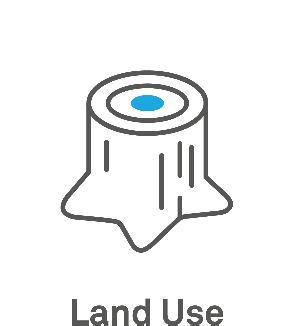
 Hardi Shah
Professor Todd Woodward
Hardi Shah
Professor Todd Woodward

Energy requirements have been an essential and accepted part of building regulations in many countries for years. However, only regulating energy and carbon in the operational aspect of buildings is not sufficient to create a net-zero society.
The American Institute of Architects has identified 10 steps that can be taken to reduce embodied carbon:

Reuse buildings instead of constructing new ones. Use low carbon concrete mixes.

Limit carbon intensive materials. Choose lower carbon alternatives. Choose carbon sequestering materials.
Reuse materials.
Use high-recycled content materials. Maximize structural efficiency. Use fewer finish materials.

10% of global ghg
In order to reduce the embodied carbon in materials, new requirements need to be introduced with limit values based on whole-life carbon assessments.

28% of global ghg
Minimize waste.
While private companies continued to commission reports to use in-house. They assessed environmental impact to be able to reduce production costs as well as environmental burden in their product systems.
Public policy however, was concerned that these REPAs would have to be conducted on thousands of products requiring micro-management and regulation of private industry. Therefore they focused on the energy profile studies that went hand in hand with the Clean Water and Clean Air Acts that were in the public eye.
Example of how private company LCAs were utilized to protect private interests: Goodyear Tire and Rubber Company uses study on 2 liter plastic (PET) containers in marketing campaign to illustrate their containers were no more environmentally burdensome than their competitors.
One of the reasons embodied impacts have seldom been considered in policy making is the misconception that factors other than operational energy demands and GHG emissions are negligible aspects of a building’s environmental performance.
The European commission followed and issued the Liquid Food Container Directive.
Society of Environmental Toxicology and Chemistry (SETAC) standards were developed. These were based on the establishment of a retrospective tool to quantify the impacts of a particular product.
The International Standards Organization ISO published the standard ISO 14000, including ISO 14040, which defined the correct process of a Life Cycle Assessment.
The first REPA was conducted by Coca Cola to quantify the raw materials and fuels used, as well as the environmental impact of the manufacturing processes.
The EPA came out with their LCA 101, a first document to support the upcoming methodology.
Companies started using environmental footprints in their marketing claims. Since there was very little standardization, this quickly became an issue.
The USA denounced the use of LCA results until further standards were in place.
Green Public Procurement (GPP) encourages governments to consider choosing products and services that cause minimal adverse environmental impacts.
ISO (the International Organization for Standardization) is a worldwide federation of national standards bodies (ISO member bodies). The work of preparing International Standards is normally carried out through ISO technical committees.
This International Standard describes the principles and framework for life cycle assessment (LCA) including
a) the goal and scope definition of the LCA
b) the life cycle inventory analysis (LCI) phase
c) the life cycle impact assessment (LCIA) phase
d) the life cycle interpretation phase
e) reporting and critical review of the LCA
f) limitations of the LCA
g) relationship between the LCA phases
h) conditions for use of value choices and optional elements
ISO 14040: covers life cycle assessment (LCA) studies and life cycle inventory (LCI) studies. It does not describe the LCA technique in detail, nor does it specify methodologies for the individual phases of the LCA.
The intended application of LCA or LCI results is considered during definition of the goal and scope, but the application itself is outside the scope of this International Standard.
The European commission followed and issued the Liquid Food Container Directive.
Society of Environmental Toxicology and Chemistry (SETAC) standards were developed. These were based on the establishment of a retrospective tool to quantify the impacts of a particular product.
The International Standards Organization ISO published the standard ISO 14000, including ISO 14040, which defined the correct process of a Life Cycle Assessment.
The first REPA was conducted by Coca Cola to quantify the raw materials and fuels used, as well as the environmental impact of the manufacturing processes.
The EPA came out with their LCA 101, a first document to support the upcoming methodology.
Companies started using environmental footprints in their marketing claims. Since there was ver y little standardization, this quickly became an issue.
The USA denounced the use of LCA results until further standards were in place.
Green Public Procurement (GPP) encourages governments to consider choosing products and services that cause minimal adverse environmental impacts.
ARCH 7340: Ecological Architecture: Professor Todd Woodward
Environmental Performance Index (epi) Mirror, Mirror, on the wall, Who’s the Greenest of them All?


The Origins & Development of Life Cycle Analysis Policy in America, UK, & Denmark

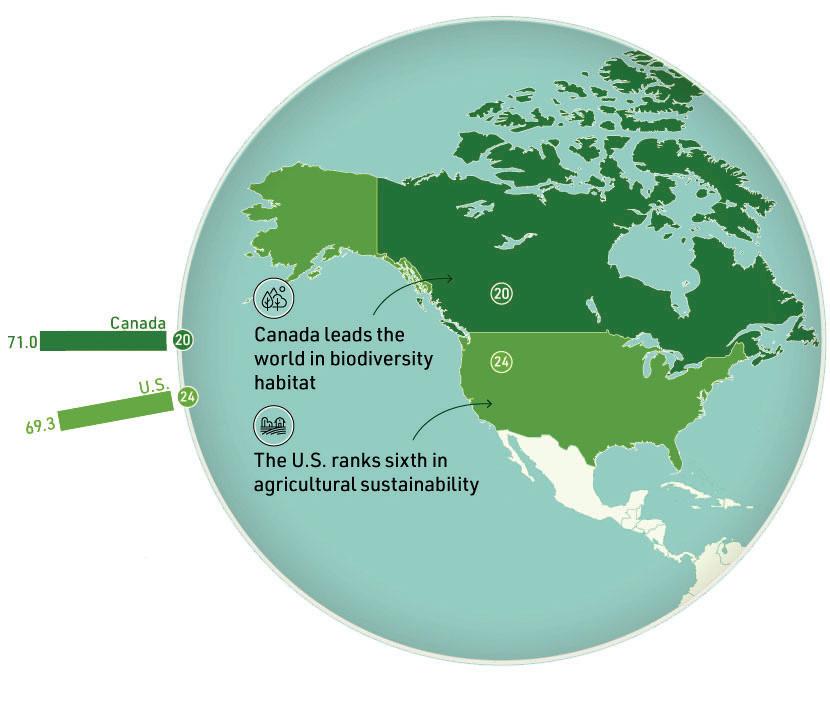


Using 40 performance indicators across 11 issue categories, the EPI ranks 180 countries on climate change performance, environmental health, and ecosystem vitality.


These indicators provide a gauge at a national scale of how close countries are to established environmental policy targets.
EPI indicators provide a way to spot problems, set targets, track trends, understand outcomes, and identify best policy practices. Good data and fact-based analysis can also help government officials refine their policy agendas, facilitate communications with key stakeholders, and maximize the return on environmental investments.
The EPI offers a powerful policy tool in support of efforts to meet the targets of the UN Sustainable Development Goals and to move society toward a sustainable future.
** 0 indicates that a country is among the worst (≥95th-percentile) in the world


CO2 Growth Rate - 100 indicates a country is cutting emissions by ≥7.59% per year
CH4 Growth Rate - 100 indicates a country is cutting emissions by ≥5.0% per year
F-gas Growth Rate - 100 indicates a country is cutting emissions by ≥3.94% per year
N2O Growth Rate - 100 indicates a country is cutting emissions by ≥1.95% per year
Black Carbon Growth Rate - 100 indicates a country is cutting emissions by ≥1.87% per year
Projected GHG Emissions - 100 indicates projected 2050 emissions equal to or below zero
CO2 from Land Cover - 100 indicates a country emits among the least amount of CO2 (≤5thpercentile) from land cover change
GHG Intensity Trend - 100 indicates that a country is successfully decoupling, with decreasing GHG intensity (≤5th-percentile of all growth rates)

For the countries chosen, the map below shows the total CO2 emissions per country in 2021. Denmark has the lowest CO2 emissions for 2021 with UK in second place and the USA at the end.
This chart shows relative change in CO2 emissions for the three selected countries. With all three starting at 0% change in 2000, we can see the dramatic reduction that the UK and Denmark have been able to make in emissions while the USA has not been able to do the same.
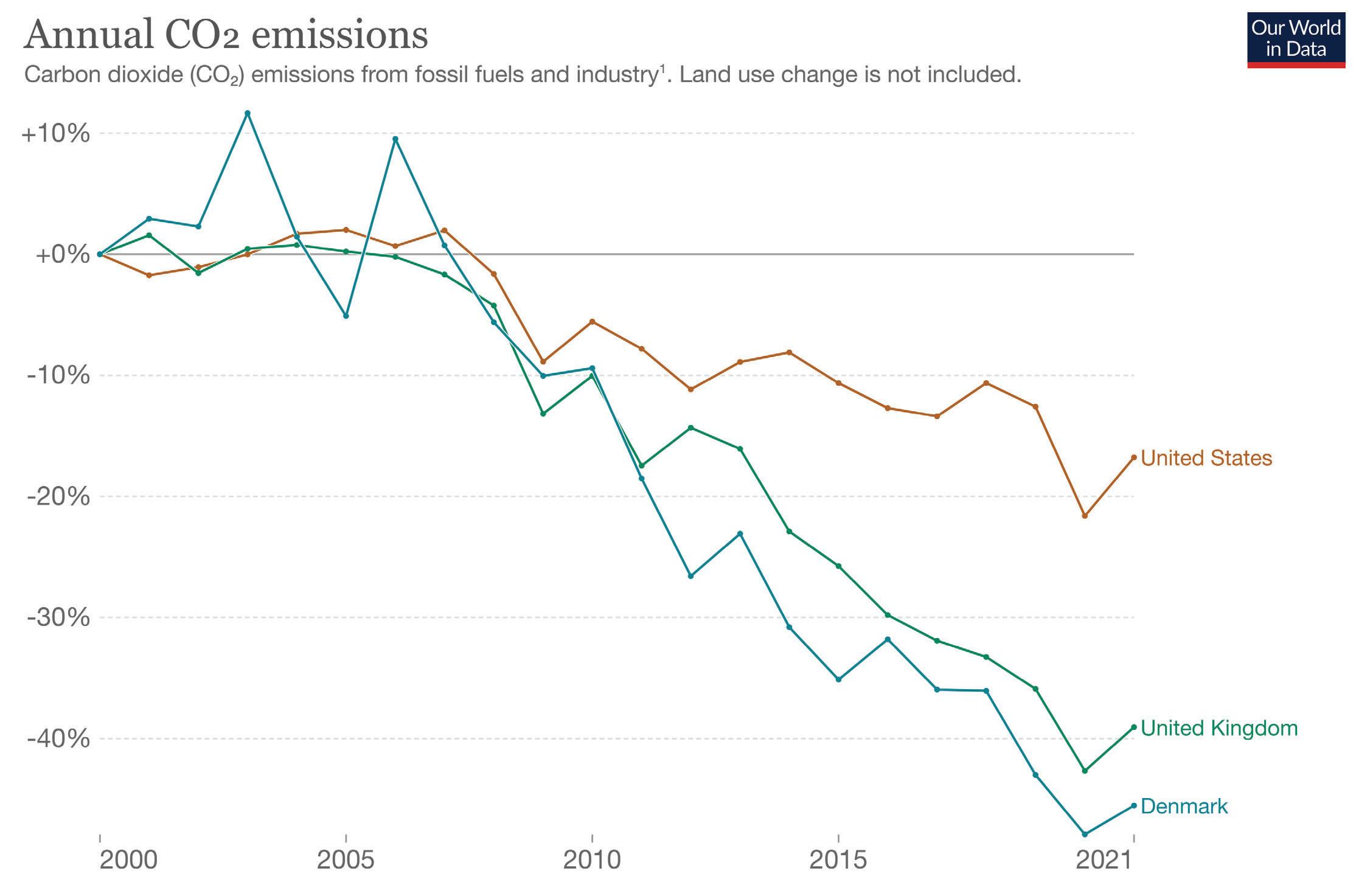
**The USA emits more than three-times its population share.

Building LCA is a mandatory part of planning regulations in many countries, including Sweden, the Netherlands, France and in parts of the UK. It is incorporated in several green building certifications such as BREEAM, LEED, DGNB, and Energie Carbone.
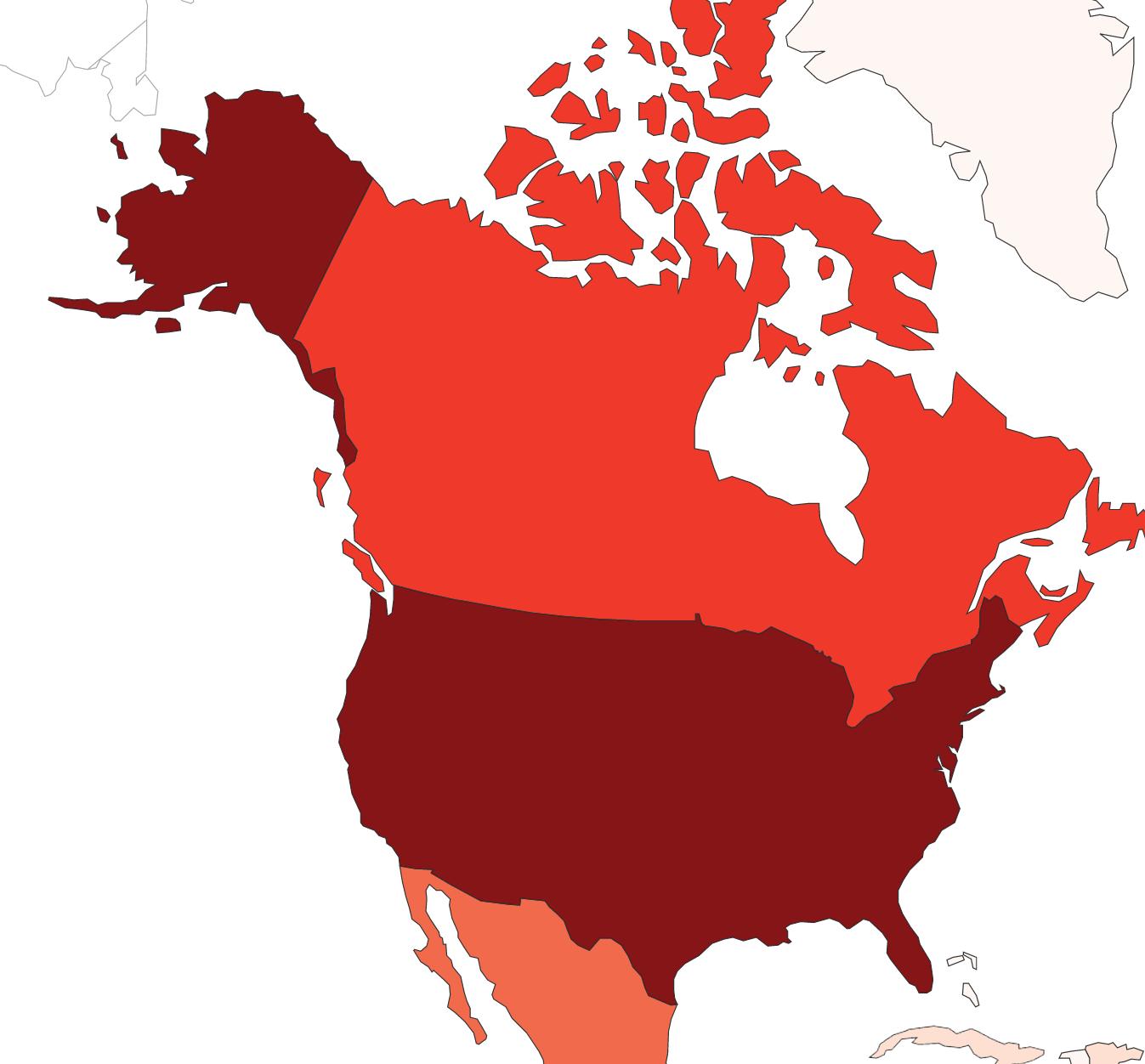
Building LCA is a mandatory part of planning regulations in many countries, including Sweden, the Netherlands, France and in parts of the UK. It is incorporated in several green building certifications such as BREEAM, LEED, DGNB, and Energie Carbone.


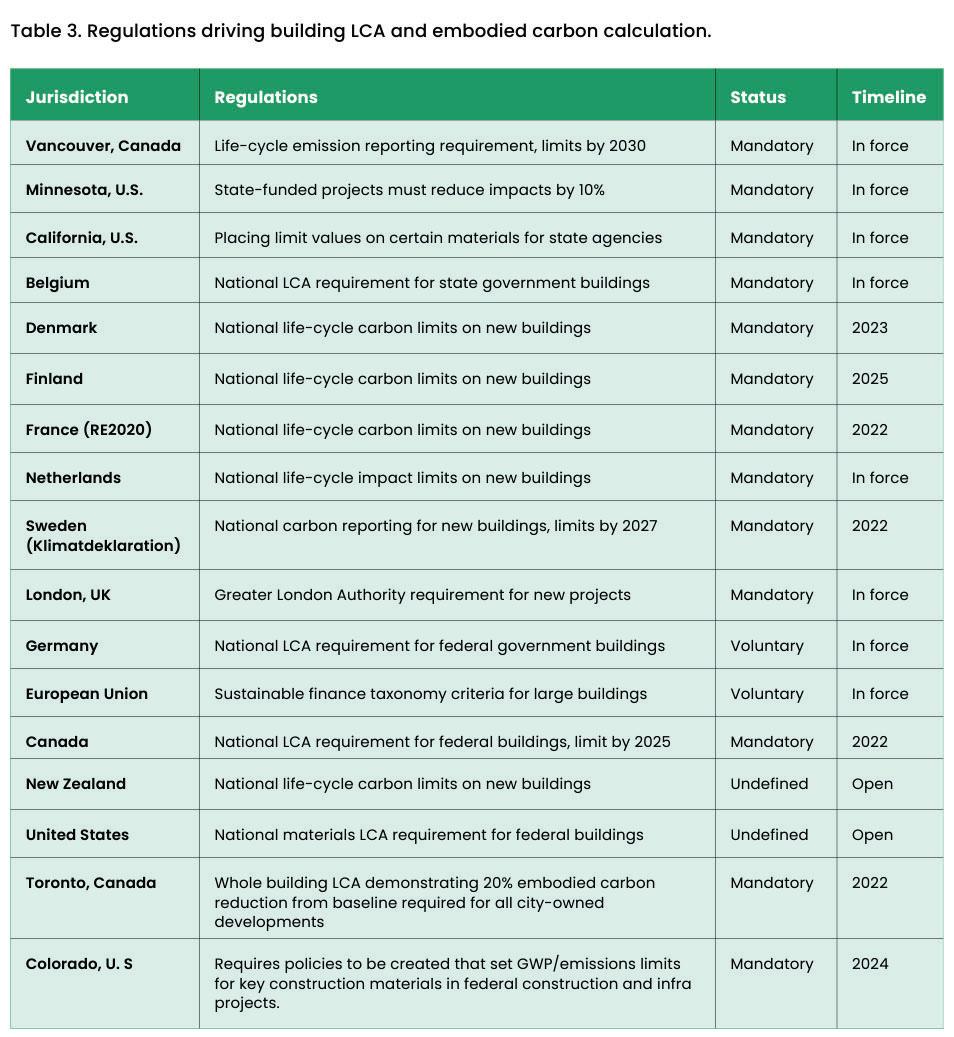
Very state-based in the USA
Building LCA is a mandatory part of planning regulations in many countries, including Sweden, the Netherlands, France and in parts of the UK. It is incorporated in several green building certifications such as BREEAM, LEED, DGNB, and Energie Carbone.



London only, requiring WBLCA for new projects
EU is largely not mandating WBLCA
Building LCA is a mandatory part of planning regulations in many countries, including Sweden, the Netherlands, France and in parts of the UK. It is incorporated in several green building certifications such as BREEAM, LEED, DGNB, and Energie Carbone.




Nordics are mandating WBLCA nationally


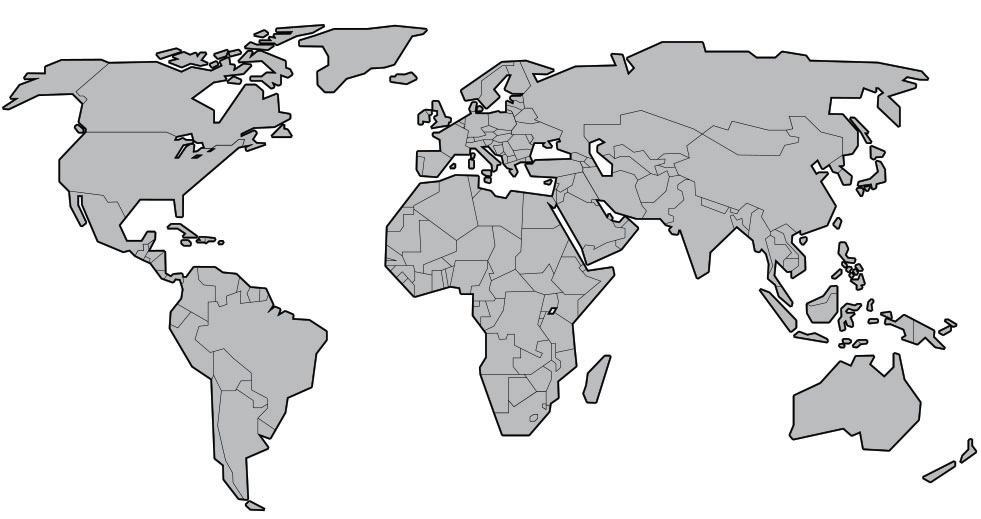
california, uSA



Requires California Air & Resources Board to develop a framework for measuring and reducing the embodied carbon of building construction materials, primarily at the materials production stage, with a target of a 40% net reduction (of 1990 levels) in GHG emissions by 2035, and an interim target of a 20% net reduction by 2030.
Conduct a whole building life assessment, including operating energy, showing that the building project achieves at least a 10% improvement for at least three of the impacts listed in Section A5.409.2.2, one of which shall be climate change, compared to a reference building of similar size, function, complexity and operating energy performance, and meeting the 2016 California Energy Code at a minimum.
The building envelope, structural elements, including footings and foundations, interior ceilings, walls and floors; and exterior finishes shall be considered in the assessment.
Exceptions:
Plumbing, mechanical and electrical systems and controls; fire and smoke detection and alarm systems and controls; and conveying systems. Interior finishes are not required to be included.
Select at least three from the following impacts in the assessment:
Climate change (greenhouse gases).

Fossil fuel depletion.
Stratospheric ozone depletion.
Acidification of land and water sources.
Eutrophication.
Photochemical oxidants (smog).
Exceptions from the whole building construction for lca
Embodied carbon from the construction and refurbishment of buildings is directly responsible for around 20%of built environment emissions in the UK and based on current figures, is likely to form over half of built environment emissions by 2035.
In contrast to the increasing regulation of operational carbon emissions of buildings, there is currently no statutory regulation of embodied emissions in the UK.


UK Net Zero Strategy sets out the government’s ambitions to help the construction sector improve reporting on embodied carbon with a view to exploring a maximum level for new buildings.
A report was produced by the Environment Audit Committee (EAC) which suggested that the: “single most significant policy” that the government could introduce to reduce carbon emissions in the built environment would be to impose a mandatory requirement for LCAs.
The UK government announced that it intends to launch a consultation in 2023 in order “to mainstream the measurement and reduction of embodied carbon.”
In the interim, the measurement and mitigation of embodied carbon in the building sector therefore remains voluntary.



London is among the cities to have already peaked its emissions.

The Future Homes and Future Building Standard (due to come into effect in 2025) is aimed at reducing the operational carbon emissions produced by new homes by 7580 percent, compared to current standards.
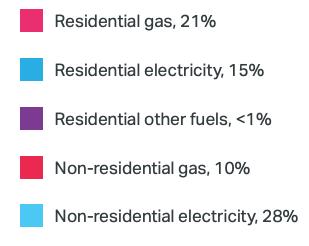
UK Net Zero Carbon Buildings Standard, which states the maximum level of embodied carbon that must not be exceeded to be a net-zero building. - this is a call for evidence to industry leaders to provide embodied carbon information.






London’s homes and workplaces are responsible for producing approximately 78% of its GHGs. The Future Homes and Future Building Standard (due to come into effect in 2025) is aimed at reducing the operational carbon emissions produced by new homes by 75-80 percent, compared to current standards.

This London Plan will require developments to contribute towards London’s ambitious target to become zero-carbon by 2050 by increasing energy efficiency.
Development proposals referable to the Mayor must calculate whole lifecycle carbon emissions through a nationally recognised Whole Life-Cycle Carbon Assessment following EN 15978 (European standard measuring building performance).
To meet the zero-carbon target, at least 35% reduction beyond the current Building Regulations is required. The minimum improvement over the Target Emission Rate (TER) will increase over a period of time in order to achieve the zero-carbon London ambition and reflect the costs of more efficient construction methods.

The London Plan requires the WLC Assessment to be done in three stages:
Pre-application: no LCA is needed, just a broad outline of the expected emissions. Planning submission: most critical stage, an LCA is needed for each life cycle. Applicants also need to provide two WLC scenarios: one with current energy needs and one based on future energy predictions.

Post-construction: this needs to be submitted within three months of completion using actual as-built data.

referable applications are residential developments > 150 units or buildings >30 m in height and commercial buildings > 2,500 m2.



It is important to note that these five countries are all quite high on Yale’s EPI. All five of these nations are closer to net-zero carbon than most other nations and in large it has to do with the introduction of LCA within policy as a mandatory or recommended item. The first four countries in the list, Sweden, Denmark, Finland, and Norway, have established LCA methodologies that govern the standardization and comparability of the submitted WBLCAs.


In 2023, voluntary regulations become mandatory and a strict, maximum value of greenhouse gas (CO2 equivalent) emissions for new buildings will be in place.


Taking into account that approximately 11% of global CO2 emissions result from manufacturing building materials, this is a crucial step for decarbonising the built environment.

Prior to the roll out of the new regulations, a voluntary sustainability standard was launched in May 2020 with the intention to test new requirements for construction, foster the development of Life Cycle Assessment (LCA) tools, promote recycling and fossil free construction sites.

Denmark
> 1,000M2 - 12KG CO2-EQ/M2/YEAR LIMIT *
< 1,000M2 - MUST CONDUCT AN LCA WITHOUT A THRESHOLD LIMIT VALUE
*This threshold value comprises all building related greenhouse gas emissions and it is for a whole life carbon analysis.

CPH2025 Climate Plan - Copenhagen will be supplied by 100% carbon neutral electricity and heat by 2025
Planned switch from coal to biomass in the combined heat and power plants with stricter EU regulations on fuel efficiency.
20% reduction in heat consumption
20% reduction of electricity consumption in commercial and service companies
10% reduction of electricity consumption in households
Schemes providing financial support:
energy savings in properties involved in urban-renewal projects, and energy savings in social housing
Municipal Buildings
Reduce the energy consumption within the municipal building stock (approx. 2 Million m2) by 40% over 2010 levels
All will be net zero carbon buildings by 2025

Hourly energy submetering for all buildings
Specific plan for social housing and municipal buildings called ‘Sustainability in Construction and Civil Works’ allows setting of more ambitious building requirements than the national codes
Now that data is more available and we know what threshold values we must meet, the challenge is to analyze and understand the effects of design decisions from all disciplines as early in the design process as possible.
The result of the Climate Plan will be CO2 reductions totalling 1.2 m tons. To help make the goal tangible, this Plan contains specific goals within the four themes of energy consumption, energy production, green mobility and City Administration initiatives.

Denmark
“This has been a challenge because clear guidance on embodied and operational carbon values and limitations has been missing.”
The Danish Agency for Housing and Planning, has introduced Bæredygtighedsklassen or the sustainability class.
The sustainability class is composed of a series of sustainability requirements which exceed those currently specified by the Danish national building regulations.

Its aim is to promote three core dimensions of sustainable construction: the environmental, social and economic:
Environmental: the impact on nature, the environment, the climate and natural resources
Social: relating to impacts on human health and wellbeing
Economic: maintaining a balance between construction cost and quality
The Sustainability Class requires that the LCA is performed and submitted twice:
An initial LCA should be submitted when applying for a building permit. Once the project is completed and final decisions have been made, the assessment should be revised and final LCA submitted when completing building registration.
The LCA guidance provided by the Danish Agency for Housing and Planning makes it clear that specific product data provided via Environmental Product Declarations (EPDs) is preferred over generic data. In addition the potential for reuse, recycling and recovery should also be included in the LCA.
Calculations consider a 50 year calculation period and the assessment includes A1-A5, B4, B6, C3, C4, and D stages.
Denmark

These requirements are more stringent every 2 years - and go from being voluntary to being required at the end of those 2 years.
Pushing policy and regulation forward every two years and moving sustainable design into the everyday norm.

> 2,500m2 - all voluntary, at least a 10% improvement for at least three of the impacts listed in Section A5.409.2.2
LCA is not required - can be performed once
A lot of undefined recommendations/ regulations surrounding LCA
Targeting a 40% net reduction (of 1990 levels) in GHG emissions by 2035, and an interim target of a 20% net reduction by 2030
> 2,500m2 - only operational, 35% reduction beyond the current Building Regulations (national baseline for that building type)
LCA is performed and submitted twice
Calculations consider an annual calculation period
The minimum improvement over the Target Emission Rate (TER) will increase over a period of time in order to achieve zero-carbon
> 1,000m2 - 12kg CO2-eq/m2/year limit (includes both operational + embodied carbon)

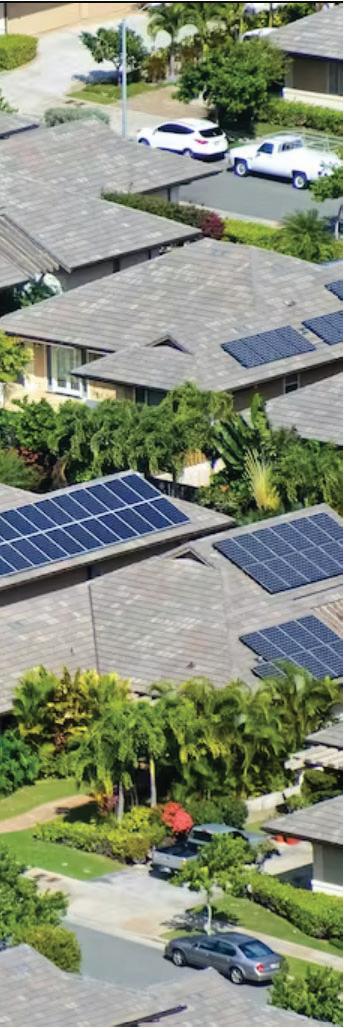


LCA is performed and submitted twice
Calculations consider a 50 year calculation period and the assessment includes A1-A5, B4, B6, C3, C4, and D stages.
These requirements are more stringent every 2 years - and go from being voluntary to being required at the end of those 2 years.
“Appendix A5: Nonresidential Voluntary Measures, California Green Building Code 2022.” n.d. UpCodes. Accessed April 17, 2023. https://up.codes/viewer/california/ca-green-code-2022/chapter/A5/ nonresidential-voluntary-measures?query=WOOD%20FRAME.
“Bæredygtighedsklassen: A New Measure to Decarbonise Construction in Denmark.” 2021. One Click LCA® Software (blog). April 16, 2021. https://www.oneclicklca.com/baeredygtighedsklassen-low-carbontargets-for-denmark-construction/.
“Buildings’ Life Cycle Assessments gain ground in the Nordics.” n.d. Accessed April 17, 2023. https:// nordicsustainableconstruction.com/news/2023/january/denmark-introduces-co2-limit-for-newconstructions.
“California Releases World’s First Plan to Achieve Net Zero Carbon Pollution – California Governor.” n.d. Accessed April 17, 2023. https://www.gov.ca.gov/2022/11/16/california-releases-worlds-first-plan-toachieve-net-zero-carbon-pollution/.
“Copenhagen, Denmark.” n.d. World Green Building Council. Accessed April 17, 2023. https://worldgbc. org/signatory/copenhagen/.
Eberhardt, Leonora Charlotte Malabi, Harpa Birgisdóttir, and Morten Birkved. 2019. “Life Cycle Assessment of a Danish Office Building Designed for Disassembly.” Building Research & Information 47 (6): 666–80. https://doi.org/10.1080/09613218.2018.1517458.
“Embodied Carbon.” 2020. ICC (blog). December 31, 2020. https://www.iccsafe.org/advocacy/embodiedcarbon/.
“Embodied Carbon | California Air Resources Board.” n.d. Accessed April 17, 2023. https://ww2.arb. ca.gov/our-work/programs/embodied-carbon.
Hammond, Geoffrey, Craig Jones, Fiona Lowrie, and Peter Tse. 2011. Embodied Carbon: The Inventory of Carbon and Energy (ICE). Bracknell: BSRIA.
Laue, Jenny. 2022. “How Denmark Leads the Way in Decarbonising the Construction Industry.” Buro Happold (blog). December 12, 2022. https://www.burohappold.com/news/how-denmark-leads-the-wayin-decarbonising-the-construction-industry/.
“London Calling: How to Meet London Plan Requirements with One Click LCA.” 2021. One Click LCA® Software (blog). March 1, 2021. https://www.oneclicklca.com/how-to-meet-london-plan-requirements/.
McManus, Marcelle C., and Caroline M. Taylor. 2015. “The Changing Nature of Life Cycle Assessment.” Biomass & Bioenergy 82 (November): 13–26. https://doi.org/10.1016/j.biombioe.2015.04.024.
Pomponi, Francesco, and Alice Moncaster. 2018. “Scrutinising Embodied Carbon in Buildings: The next Performance Gap Made Manifest.” Renewable and Sustainable Energy Reviews 81 (January): 2431–42. https://doi.org/10.1016/j.rser.2017.06.049.
Roberts, David. 2017. “California Has a Climate Problem, and Its Name Is Cars.” Vox. August 22, 2017. https://www.vox.com/energy-and-environment/2017/8/22/16177820/california-transportation.
Röck, Martin, Marcella Ruschi Mendes Saade, Maria Balouktsi, Freja Nygaard Rasmussen, Harpa Birgisdottir, Rolf Frischknecht, Guillaume Habert, Thomas Lützkendorf, and Alexander Passer. 2020. “Embodied GHG Emissions of Buildings – The Hidden Challenge for Effective Climate Change Mitigation.” Applied Energy 258 (January): 114107. https://doi.org/10.1016/j.apenergy.2019.114107.
“The London Plan 2021 | London City Hall.” n.d. Accessed April 17, 2023. https://www.london.gov.uk/ programmes-strategies/planning/london-plan/new-london-plan/london-plan-2021.
“Welcome | Environmental Performance Index.” n.d. Accessed April 17, 2023. https://epi.yale.edu/.
“What You Should Know about the Green Public Procurement Report.” 2022. January 31, 2022. https:// blogs.worldbank.org/governance/what-you-should-know-about-green-public-procurement-report.
“Whole Building Life Cycle Assessment.” n.d. UpCodes. Accessed April 17, 2023. https://up.codes/s/ whole-building-life-cycle-assessment.
“Why Building Regulations Must Incorporate Embodied Carbon.” 2021. Buildings and Cities. October 30, 2021. https://www.buildingsandcities.org/insights/commentaries/building-regulations-embodied-carbon. html.
Wood, Therese. 2021. “Mapped: The Greenest Countries in the World.” Visual Capitalist. February 25, 2021. https://www.visualcapitalist.com/greenest-countries-in-the-world/.
The Origins & Development of Life Cycle Analysis Policy in America, UK, & Denmark